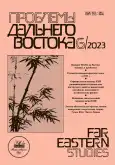NATO's Pivot to the East: Motives and Problems
- Авторлар: Kistanov V.O.1
-
Мекемелер:
- Institute of China and Contemporary Asia of the RAS
- Шығарылым: № 6 (2023)
- Беттер: 9-20
- Бөлім: Articles
- URL: https://journals.rcsi.science/0131-2812/article/view/251187
- DOI: https://doi.org/10.31857/S013128120028839-3
- ID: 251187
Толық мәтін
Аннотация
Негізгі сөздер
Авторлар туралы
Valeriy Kistanov
Institute of China and Contemporary Asia of the RAS32, Nakhimovsky Av., Moscow, 117997, Russian Federation
Әдебиет тізімі
- Кистанов В.О. «Глобальная Британия»: курс на АТР с антикитайским уклоном // Восточная Азия: факты и аналитика. 2021. № 3. С. 6–18. doi: 10.24412/2686–7702–2021–3–6–18
- Кистанов В. О. Китай как фокус стратегии Японии в сфере безопасности // Проблемы Дальнего Востока. 2023. № 3. C. 40–57. doi: 10.31857/S013128120026064–1
- Парамонов О. Кэмп-Дэвид и «азиатское НАТО» // Международная жизнь. 23.08.2023. URL: https://interaffairs.ru/news/show/41896?ysclid=llxu2ehde9927966703 (дата обращения: 25.09.2023).
- Individually Tailored Partnership Programme between NATO and Japan for 2023–2026 // North Atlantic Treaty Organization. July 12, 2023. URL: https://www.nato.int/cps/en/natohq/official_texts_217797.htm?selectedLocale=en (дата обращения: 15.07.2023).
- Hanssen Ulv, Hagström Linus. The errors of NATO’s East Asia engagement // East Asia Forum. August 25, 2023. URL: https://www.eastasiaforum.org/2023/08/25/the-errors-of-natos-east-asia-engagement/ (дата обращения: 28.08.2023).
- Koga Kei. How AUKUS Plus could add to Indo-Pacific coalition building // East Asia Forum. November 1, 2023. URL: https://www.eastasiaforum.org/2023/11/01/how-aukus-plus-could-add-to-indopacific-coalition-building/?utm_source=subscribe2&utm_medium=e mail&utm_campaign=postnotify&utm_id=2253034&utm_title=How%20AUKUS%20Plus%20could%20add%20to%20Indo-Pacific%20coalition%20building (дата обращения: 02.11.2023).
- Narine Shaun. NATO should tread carefully in the Indo-Pacific // Asia Times. May 30, 2023. URL: https://asiatimes.com/2023/05/nato-should-tread-carefully-in-the-indo-pacific/ (дата обращения: 22.09.2023).
- National Security Strategy of Japan // Ministry of Foreign Affairs of Japan. December 2022. URL: https://www.cas.go.jp/jp/siryou/221216anzenhoshou/nss-e.pdf (дата обращения: 05.03.2023).
- NATO 2022 Strategic Concept. Adopted by Heads of State and Government at the NATO Summit in Madrid // North Atlantic Treaty Organization. June 29, 2022. URL: https://www.nato.int/nato_static_fl2014/assets/pdf/2022/6/pdf/290622-strategic-concept-ru.pdf (дата обращения: 15.09.2023).
- Stoltenberg Yens. A Stronger NATO for a More Dangerous World // Foreign Affairs. July 10, 2023. URL: https://www.foreignaffairs.com/europe/stronger-nato-more-dangerous-world-vilnius-jens-stoltenberg (дата обращения: 12.09.2023).









